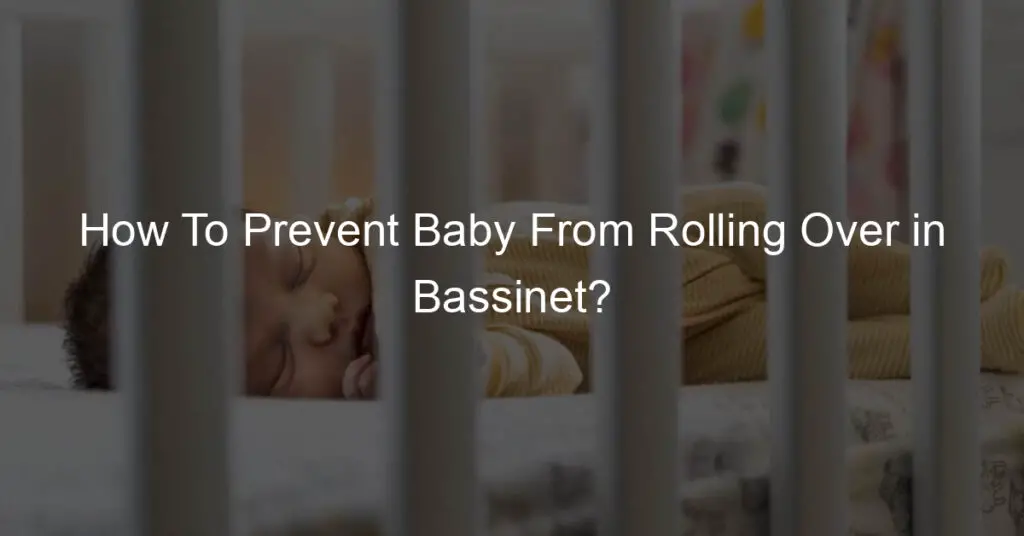Introduction to Baby Safety in the Bassinet
Ensuring the safety of your baby while they sleep is a top priority for every parent. One of the most common places for a baby to sleep is in a bassinet. It’s crucial to understand the importance of baby safety in the bassinet and be aware of common concerns about baby sleep safety. This article will provide you with essential information and tips to ensure your baby’s safety.
Importance of baby safety in the bassinet
The bassinet is often the first sleeping environment for a newborn. It’s designed to provide a cozy, comfortable, and safe space for your baby. However, it’s essential to ensure that the bassinet is used correctly to prevent any potential risks. Baby safety in the bassinet is crucial because it can significantly reduce the risk of Sudden Infant Death Syndrome (SIDS) and other sleep-related accidents. According to Wikipedia, SIDS is the unexplained death, usually during sleep, of a seemingly healthy baby less than a year old. Therefore, ensuring the safety of your baby in the bassinet is not just about comfort, but it’s also a matter of life and death.
Common concerns about baby sleep safety
There are several common concerns that parents have about baby sleep safety. These include the baby’s sleep position, the risk of the baby rolling over in the bassinet, the use of blankets and toys in the bassinet, and the general condition and safety features of the bassinet itself. All these factors can contribute to the overall safety of your baby while they sleep. It’s important to address these concerns and take necessary precautions to ensure your baby’s safety.
In the following sections, we will delve deeper into understanding baby sleep positions, preventing baby rolling in the bassinet, and other essential bassinet safety tips. Stay tuned to learn more about how you can ensure a safe and secure sleep environment for your little one.
Understanding Baby Sleep Positions
As a parent, understanding your baby’s sleep positions is crucial for their safety and comfort. Babies have different sleep positions, each with its unique benefits and considerations. Let’s delve into the common baby sleep positions.
Common Baby Sleep Positions
- Back Sleeping:Back sleeping is the safest position for your baby. It significantly reduces the risk of Sudden Infant Death Syndrome (SIDS). In this position, your baby’s face is up, and there’s nothing covering their nose or mouth. This position allows for maximum airflow and is recommended by the American Academy of Pediatrics.
- Side Sleeping:Side sleeping is another common position for babies. However, it’s not as safe as back sleeping. There’s a risk that your baby might roll onto their stomach, which can increase the risk of SIDS. If you choose this position, ensure you use a sleep positioner to prevent rolling.
- Stomach Sleeping:Stomach sleeping is not recommended for infants due to the increased risk of SIDS. In this position, your baby’s face might be close to the mattress or bedding, which can obstruct their breathing. However, once your baby can roll over independently, they might choose this position themselves.
Understanding these sleep positions can help you make informed decisions about your baby’s sleep habits. Always remember, the safety of your baby is paramount. If you have any concerns about your baby’s sleep positions, consult with a healthcare professional.
Safe Baby Sleep Practices
Ensuring the safety of your baby while they sleep is paramount. Here are some practices that have been proven to enhance the safety of babies during sleep:
1. Always placing baby on their back for sleep: According to the American Academy of Pediatrics, the safest position for a baby to sleep is on their back. This position reduces the risk of Sudden Infant Death Syndrome (SIDS) by as much as 50%. It’s important to maintain this position until the baby is capable of rolling over independently.
2. Keeping the bassinet free from loose bedding and toys: Loose bedding and toys can pose a suffocation risk for your baby. Ensure that the bassinet is free from such items. A fitted sheet is all that’s needed for your baby’s comfort. Remember, a clutter-free bassinet is a safer bassinet.
3. Ensuring the baby is not overheated: Overheating can lead to discomfort and increase the risk of SIDS. Dress your baby in light, breathable clothing and keep the room at a comfortable temperature. If your baby’s chest feels hot or they’re sweating, they may be overheated. Always monitor your baby’s temperature to ensure they are comfortable and safe.
By adhering to these safe sleep practices, you can significantly reduce the risk of sleep-related accidents and ensure your baby gets a good night’s sleep.
Preventing Baby Rolling in the Bassinet
Ensuring your baby’s safety during sleep is a top priority for every parent. One common concern is the baby rolling over in the bassinet. Let’s delve into understanding why this happens and how it can be prevented.
Why Do Babies Roll Over in Sleep?
There are primarily two reasons why babies roll over during their sleep:
- Developmental milestones: Rolling over is a significant developmental milestone that your baby achieves during their growth. It typically starts when the baby is around 3 to 6 months old. This is a sign that your baby’s muscles are developing and they are learning to move independently. However, this can also mean that they might roll over while sleeping. Read more about developmental milestones here.
- Comfort seeking: Just like adults, babies also seek comfort during their sleep. They might roll over to find a more comfortable position. This is completely natural, but it can sometimes lead to safety concerns if the baby rolls over and is unable to roll back.
Understanding these reasons can help in devising strategies to prevent your baby from rolling over in the bassinet. Remember, the aim is to ensure a safe and comfortable sleep for your baby.
How to Stop Baby from Rolling Over
As a parent, it can be a cause for concern when your baby starts rolling over in their sleep. Here are some effective strategies you can use to prevent this:
Using a baby sleep sack
A baby sleep sack is a wearable blanket that can help keep your baby safe during sleep. It restricts your baby’s movement, making it harder for them to roll over. It also keeps them warm without the risk of suffocation associated with loose blankets. A study by the American Academy of Pediatrics found that using a sleep sack can reduce the risk of Sudden Infant Death Syndrome (SIDS) by 50%.
Practicing tummy time during the day
Tummy time is an important activity that helps your baby develop their neck, shoulder, and arm muscles. By strengthening these muscles, your baby will have better control over their movements, reducing the likelihood of them rolling over unintentionally during sleep. Aim for about 15-30 minutes of tummy time a day, broken up into shorter sessions.
Monitoring baby’s sleep
Keeping a close eye on your baby during sleep can help you intervene if they start to roll over. Consider using a baby monitor with a video feature for this purpose. Remember, it’s normal for babies to move around during sleep, but if they seem uncomfortable or distressed, it might be time to adjust their sleeping arrangements.
Remember, every baby is unique and what works for one might not work for another. It’s important to try different strategies and see what works best for your baby. Always consult with your pediatrician if you have any concerns about your baby’s sleep habits.
Bassinet Safety Tips
When it comes to your baby’s safety, every detail matters. One of the most important aspects to consider is the bassinet, a small bed designed specifically for infants. Here are some tips to help you choose a safe bassinet for your little one.
Choosing a Safe Bassinet
When selecting a bassinet, there are two main factors to consider: safety standards and the size and weight limit. Let’s delve into these two aspects.
Checking for Safety Standards
Always ensure that the bassinet you choose meets the current safety standards. Look for a certification seal from a reputable organization such as the Juvenile Products Manufacturers Association (JPMA). This certification indicates that the product has been tested and meets the safety standards set by ASTM International. You can find more information about these standards on the Wikipedia page for ASTM International.
Considering the Size and Weight Limit
Another crucial factor to consider is the size and weight limit of the bassinet. Ensure that the bassinet is spacious enough for your baby to move comfortably, but not too large that they could roll over and get trapped. The weight limit is also important. Most bassinets can hold babies up to 15 to 20 pounds, but it’s always best to check the manufacturer’s specifications. Remember, once your baby exceeds the weight limit or starts to push up on their hands and knees, it’s time to transition them to a crib.
By keeping these tips in mind, you can ensure that your baby’s bassinet is a safe and comfortable place for them to rest.
Proper Use of a Bassinet
Ensuring the safety of your baby while they sleep is a top priority. One of the ways to achieve this is by using a bassinet correctly. Here are two essential steps to follow:
Placing the Bassinet in a Safe Location
The location of the bassinet in your home plays a crucial role in your baby’s safety. It should be placed in a quiet, well-ventilated area, away from windows, heaters, and other potential hazards. Avoid placing the bassinet near curtains or blinds, as the cords can pose a strangulation risk. It’s also important to ensure that the bassinet is on a flat, stable surface to prevent tipping over.
Regularly Checking the Bassinet for Wear and Tear
Regular inspection of the bassinet is essential to ensure it remains safe for your baby. Check for any signs of wear and tear, such as loose screws, broken parts, or frayed fabric. If you notice any damage, stop using the bassinet immediately and either repair it or replace it. Remember, your baby’s safety is paramount.
In conclusion, the proper use of a bassinet involves more than just putting your baby to sleep in it. It requires careful placement and regular inspection to ensure it remains a safe sleeping environment for your baby.
Newborn Safety in the Bassinet
Ensuring the safety of your newborn while they sleep in their bassinet is a top priority for every parent. There are certain special considerations that need to be taken into account to ensure your baby’s safety and comfort.
Special Considerations for Newborns
When it comes to newborns, there are two key factors that parents should be aware of: the importance of swaddling and understanding newborn sleep patterns.
Importance of Swaddling
Swaddling is a traditional practice of wrapping babies in blankets or similar cloths so that movement of the limbs is tightly restricted. Swaddling is used to calm and soothe a newborn and promote sleep. According to a study, swaddled babies tend to sleep more and cry less compared to unswaddled babies. However, it’s crucial to swaddle your baby correctly to avoid any potential risks such as hip dysplasia or overheating.
Understanding Newborn Sleep Patterns
Newborns have different sleep patterns compared to adults. They typically sleep in cycles of 2-3 hours, waking up for feeding in between. Understanding these patterns can help you ensure your baby is getting enough sleep and can also help you anticipate their needs. A study shows that newborns need about 14 to 17 hours of sleep a day, including naps. Recognizing and respecting your baby’s sleep patterns can contribute to their overall health and development.
By taking these special considerations into account, you can ensure your newborn’s safety and comfort in the bassinet.
Addressing Newborn Sleep Concerns
As parents, we all want our newborns to sleep safely and soundly. However, there are certain sleep concerns that are common in newborns. Let’s delve into these issues and understand how to address them effectively.
-
- Dealing with Reflux and Colic
Reflux and colic are two conditions that can disrupt your newborn’s sleep. Reflux, also known as gastroesophageal reflux, occurs when the stomach contents flow back up into the esophagus. This can cause discomfort and disrupt your baby’s sleep. Colic, on the other hand, is characterized by frequent, prolonged, and intense crying or fussiness in a healthy infant. It can also interfere with sleep.
Here are some tips to deal with these conditions:
-
-
- Keep your baby upright during feedings and for at least 30 minutes after to help prevent reflux.
- Try different feeding techniques, such as smaller, more frequent feedings, to help manage colic.
- Use a pacifier. Sucking on a pacifier can soothe a colicky baby and help them fall asleep.
- Understanding the Risk of SIDS
-
Sudden Infant Death Syndrome (SIDS) is a cause of worry for many parents. It’s the unexplained death, usually during sleep, of a seemingly healthy baby less than a year old. Although the exact cause of SIDS is unknown, certain factors may increase the risk. These include sleeping on the stomach or side, overheating during sleep, and exposure to cigarette smoke.
Here are some measures to reduce the risk of SIDS:
Always place your baby on their back to sleep, for both naps and at night.
Use a firm sleep surface, such as a mattress in a safety-approved crib, covered by a fitted sheet.
Keep soft objects, toys, and loose bedding out of your baby’s sleep area.
Avoid exposure to smoke, alcohol, and illicit drugs.
Remember, every baby is unique and what works for one might not work for another. It’s important to understand your baby’s needs and respond accordingly. If you’re ever in doubt, don’t hesitate to consult with a healthcare professional.
Conclusion: Ensuring Secure Baby Sleep
As we conclude this comprehensive guide on baby sleep safety, it’s crucial to remember that the safety and well-being of your child is paramount. The practices and tips discussed in this article are designed to help you create a safe and comfortable sleeping environment for your baby. Let’s recap the key points.
- Recap of baby sleep safety practices: Always place your baby on their back to sleep. Ensure the bassinet is free from loose bedding, toys, and other potential hazards. The mattress should be firm and fit snugly within the bassinet. Regularly check the bassinet for any wear and tear that could pose a risk. Remember, it’s safer for your baby to sleep in the same room as you for the first six months, but not in the same bed.
- Importance of parental vigilance and awareness: Parents and caregivers must remain vigilant and aware of their baby’s sleep habits and environment. Regularly monitor your baby while they sleep and promptly address any potential risks. Stay informed about the latest safety guidelines and recommendations. Your awareness and vigilance are crucial in ensuring your baby’s safety.
Remember, every baby is unique and may have different sleep patterns and needs. It’s essential to understand your baby’s individual needs and adjust your practices accordingly. The safety tips and practices discussed in this article are general guidelines and may not apply to every situation. Always consult with a healthcare professional if you have any concerns or questions about your baby’s sleep safety.
Ensuring secure baby sleep is a shared responsibility that requires consistent effort and awareness from everyone involved in the baby’s care. By following these safety practices and staying vigilant, you can provide your baby with a safe and comfortable sleep environment.














